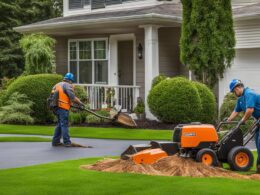Are you considering leveling your yard for a construction project or simply want to create a more visually appealing outdoor space? Understanding the cost to level a yard and its impact on your landscaping investment is crucial. Yard leveling is a necessary step in establishing a stable foundation, whether it’s for a residential or commercial project. By excavating and removing soil to create a level surface, you ensure the longevity and durability of your construction efforts.
The cost of leveling a yard can vary depending on several factors. These include the size of the project, difficulty of access, soil type, and the equipment used. Excavation costs are typically priced per cubic yard of soil removed. Small projects may average around $100 per hour, while larger projects can exceed $500. Other influencing factors include the time of year, project location, and specific soil conditions, all of which can contribute to the overall cost of leveling a yard.
Planning and budgeting for a yard leveling project is essential to avoid any surprises. By understanding the factors that can influence the cost and having a clear picture of the project’s scope, you can make informed decisions. Consider consulting with professionals in the landscaping industry, as their expertise can help you create accurate estimates and develop a comprehensive plan.
By taking the time to research and assess the cost to level a yard, you can ensure that your landscaping investment is optimized. A well-planned project not only creates a visually appealing outdoor space but also adds value to your property. So, start planning your yard leveling project today and make the most out of your landscaping investment.
Factors Affecting Yard Leveling Costs
When it comes to leveling a yard, several factors come into play that can impact the overall costs. Understanding these factors is essential to plan and budget effectively for your project. From excavation costs to grading, cut and fill, and land leveling, each aspect contributes to the final price.
Excavation Costs
Excavation costs are primarily determined by the volume of dirt that needs to be removed. It’s no surprise that larger projects will incur higher costs compared to smaller ones. Additionally, the type of equipment used during the excavation process can influence pricing due to the maintenance expenses associated with more specialized machinery.
Grading
Grading, which involves adjusting the slope and soil elevation, is another crucial factor affecting yard leveling costs. The cost of grading varies depending on the size of your yard and the existing site conditions. On average, you can expect grading costs to range from $500 to $5000.
Cut and Fill
Another consideration is the process of cut and fill, which involves the movement of excess soil. This can lead to additional expenses in terms of materials, labor, and equipment. It’s important to account for these costs when planning your yard leveling project.
Land Leveling
The final step in yard leveling is land leveling itself, which is the process of flattening and smoothing the surface. The cost of land leveling can vary based on the type of project. For residential projects, it typically falls within the range of $1000 to $6000. The specific terrain, soil type, and location also impact the total cost.
Considering these factors, along with the unique characteristics of your property, will help you determine the overall cost of leveling your yard. By carefully evaluating all aspects, you can effectively plan your budget and ensure a successful landscaping project.
Tips for Optimizing Your Landscaping Investment
To optimize your landscaping investment and reduce costs, consider implementing the following strategies:
- Choose permeable hardscapes – Opt for materials like gravel or decomposed granite to cover open spaces. These permeable options not only provide a visually appealing look but also help save on material costs.
- Be strategic with groundcover plantings – Utilize groundcover plants that cover a lot of square footage without the need for many plants. This cost-effective approach can add greenery to your landscaping without breaking the bank.
- Reuse existing materials and structures – Instead of demolishing and replacing old structures, find ways to repurpose them. This can help save money on demolition costs while adding a unique touch to your outdoor space.
- Purchase smaller plants and properly prepare the soil – By opting for smaller plants and preparing the soil correctly, you can promote faster growth and save on landscaping costs in the long run.
- Consider prefabricated structures – Explore options like precast patio covers and outdoor seating. These cost-effective solutions can add functionality and aesthetic appeal to your outdoor area without breaking the bank.
- Evaluate long-term landscaping maintenance costs – Factor in the ongoing maintenance expenses before finalizing your landscaping plans. Opt for low-maintenance options like native plants or xeriscaping to minimize upkeep costs over time.
Implementing these cost-saving strategies can help you optimize your landscaping investment and create a beautiful outdoor space while staying within your budget.
The Cost of Professionally-Designed Landscapes
The cost of a professionally-designed landscape can vary depending on the features included, the size of the yard, and the overall scope of the project. When it comes to building a landscape from professional designs, the national average cost is around $30,000. However, it’s important to note that budgets can range from $15,000 to $150,000 or even more.
This cost includes the installation of various landscape elements, such as specimen trees, hardscaping, built-in seating, and retaining walls. These features not only enhance the aesthetic appeal of your outdoor space but also contribute to its functionality and value.
To ensure that the design aligns with your budget, it’s crucial to have an open discussion about your financial constraints with the design team. By doing so, they can work within your specified budget and suggest alternative options or cost-saving strategies to achieve your desired landscape.
When deciding on the features for your landscape, prioritize those that are most important to you and align with your vision. This will help you allocate the budget effectively and ensure that the essential elements are included in the design.
By carefully considering the cost of landscape installation and making informed decisions about the features you want to incorporate, you can make the most of your landscaping budget. Professional designers have the expertise to create a visually stunning and functional outdoor space while keeping costs in check. With their guidance and your input, you can transform your yard into a beautiful oasis that reflects your style and enhances your property’s curb appeal.
What is the Cost Breakdown for Leveling a Yard Including Mulch Prices?
When considering the cost breakdown for leveling a yard, it’s important to factor in mulch prices. Mulch not only completes the landscaping but also helps maintain moisture and temperature for plants. To make informed decisions, uncover mulch prices today to stay within your budget and achieve a polished yard.
Conclusion
Undertaking landscaping projects, such as yard leveling, involves careful consideration of costs and factors that can impact your budget. By understanding these factors, you can plan and budget effectively for your landscaping investment. Implementing cost-saving strategies and prioritizing essential features can help you create a visually appealing outdoor space that is also cost-effective.
To optimize your landscaping budget, consider utilizing permeable hardscapes, strategic groundcover plantings, and reusing existing materials. Purchasing smaller plants and preparing the soil properly can also help you save on landscaping costs. Additionally, evaluating long-term maintenance costs and opting for low-maintenance options can minimize ongoing expenses.
Remember, with proper planning and the guidance of a professional, you can achieve your desired landscaping goals within your budget. Creating a cost-effective and aesthetically pleasing outdoor space is possible when you strategize and make informed decisions. So take these budgeting tips into account and embark on your landscaping project with confidence.










